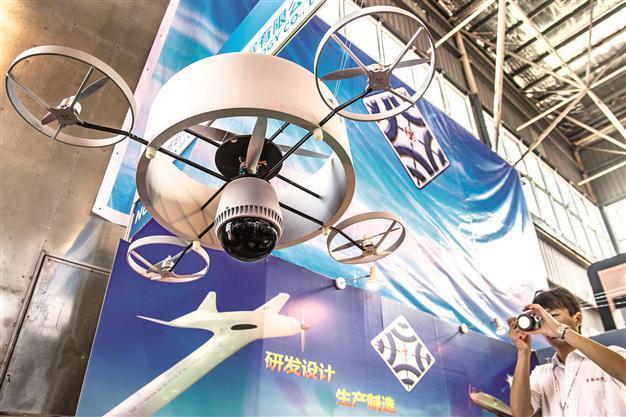China parades arms as US firm on Pacific shift
ZHUHAI / PERTH - Agence France-Presse

A Chinese-made drone equipped with a surveillance camera and the ‘Yi Long’ drone (inset) by China Aviation Industry Corporation (AVIC) are displayed during the 9th China International Aviation and Aerospace Exhibition in Zhuhai. The show comes as Pentagon says it is firm on its shift to Asia-Pasific. AFP Photo
China flaunted a new military drone yesterday along with a model of a next-generation fighter plane as proof it is building up its own defense capabilities, while the United States insisted its much-touted shift to the Asia-Pacific region is due to a real and long-term project.China Aviation Industry Corporation (AVIC) displayed its “Yi Long” drone, called Wing Loong in English, at the opening of China’s premier air show in the southern city of Zhuhai, state media said. The show comes as China’s Communist Party holds a meeting to select the country’s new leaders, including a head for the party’s Central Military Commission, which controls the armed forces.
US pushes Pacific shift
AVIC also showed a model of a new generation fighter jet that the Chinese media said was the J-31. Hong Kong’s South China Morning Post newspaper put the price of the Chinese drone at around $1 million. China’s first stealth fighter, the J-20, was unveiled in early 2011 but is not expected to enter service until 2018. Chinese President Hu Jintao last week called for China to step up the military’s technological abilities, saying its most important task was to be able to “win a local war in an information age.”
As a response to China’s growing economic and military influence, Washington is pushing ahead with a shift of focus to the Asia-Pacific region, which was announced at the start of the year. About 250 U.S. Marines arrived in northern Australia this year as part of an American “rebalance” toward the Pacific after a decade of ground wars in Iraq and Afghanistan.
The move to station Marines here - some 2,500 by 2016 and 2017 - represents a significant strategic shift by Washington and has irked Beijing, whose rapid rise is behind the U.S. recalibration of forces to Asia. U.S. Pentagon chief Leon Panetta told reporters yesterday that the Americans were ready to follow through on a plan to pivot to the Pacific despite crises in the Middle East and fiscal strains at home.
“The rebalance is real. It’s going to be long-term,” Panetta said before the start of his two-day trip to Australia.
The U.S. is expanding military exercises with allies and gradually moving its most advanced ships, weaponry and aircraft to Asia, including deploying Marines to northern Australia, as part of a long-term strategy, he said. But that did not mean having to scale back its military presence in the volatile Middle East, Panetta said. “I feel very comfortable with regards to how we’re dealing with threats in the Middle East,” he said.
It was possible for the American military “to walk and chew gum at the same time,” said Panetta, in his third trip to Asia since June. In what could be her final visit in her current job, U.S. Secretary of State Hillary Clinton joined Panetta for talks with Australian counterparts Bob Carr and Stephen Smith.
Gen. Martin Dempsey, the chairman of the Joint Chiefs of Staff will also be joining the talks, the Washington Post reported.
Russia vows ‘sharp act’
MOSCOW
Russia will “react in the sharpest manner” to any U.S. ships equipped with the Aegis combat system attempting to sail by its shores, Russian Deputy Prime Minister Dmitry Rogozin told RIA Novosti news agency on Nov. 12.
Rogozin did not elaborate on Russia’s possible reaction, but lambasted the U.S. missile defense system, part of which involves ships equipped with the Aegis integrated naval weapons system, for fuelling “an arms race.” Russia is developing new S-500 interceptor missiles and does not rule out stationing radar systems outside its territory. But Moscow has no plans to station its missiles in other countries, unlike the U.S., Rogozin said. “We have never placed our missiles near U.S. borders on ridiculous, fabricated pretexts such as ‘protecting our American friends from Canada and Honduras.’ But they do, on the pretext of protecting us and Europe from ‘bad guys in Iran and North Korea,’” Rogozin added.
Russia opposes the U.S. plan to place its missile defense, claiming that its own ballistic missiles would also be covered by the U.S. shield.
















